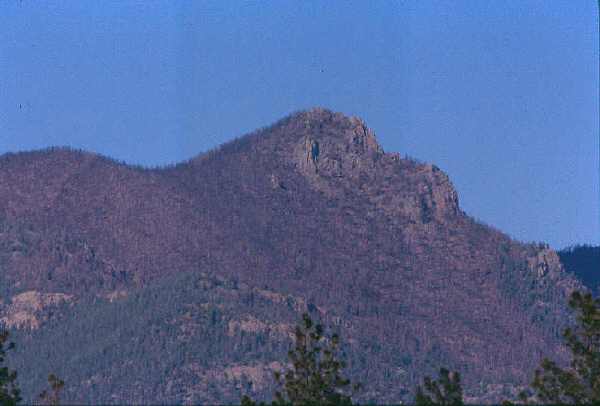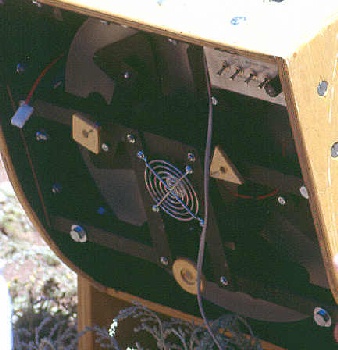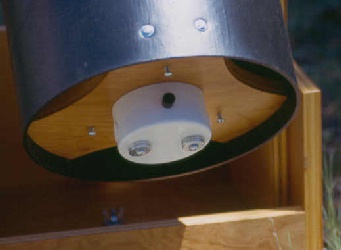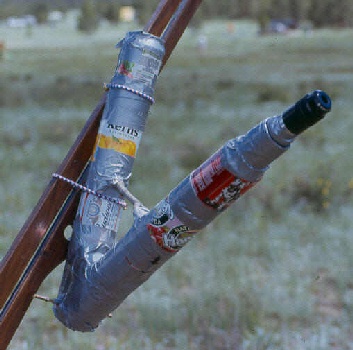
(with a little commentary on the party itself)
RMSS '03 was a gas as usual. Fortunately, last year's "Hayman" forest fire which started about four miles from the CSAS observing site left the site unscathed. (This was the largest area burned in one fire in recorded Colorado history to date and started Saturday afternoon during RMSS '02.) The picture below, taken from the observing site one year later, shows one mountain side that burned a day or two after the fire started. In the foreground is an unburned hillside.

Since the Colorado Springs Astronomical Society is the sister club to the Aussie club down under at Stromlo in Oz, this year's proceeds from Star Stare are going down south to help out with the recovery effort from the recent fire which destroyed the Mt. Stromlo observatory (many buildings, domes, and historical instruments) which housed the library and meeting place for the club.
In contrast to last year's sun-scorched and dessicated landscape where not one green blade of grass was to be seen, the observing fields at Star Stare this year were lush and grassy with flowers, and the sweet tang of fresh sage was thick in the air night and day. Last year's hot wind was pleasantly absent as well, and the single fat humming bird observed bore testament to the high level of food supply, as they obviously had more to keep them occupied than last year when the hungry little buggers buzzed us like flies. Mosquitos were few and far between and the little biting flies in the day time posed the greatest nuisance, which was minimal at worst.
I arrived noonish on Thursday to find only the north end of the main O'Brien gulch field occupied and only two other campsites in the southern area staked out. Later in the afternoon a slow stream of vehicles bearing telescopes and photon seekers began trickling in. By Saturday evening some 325 folks had registered.
Thursday night was mostly clear until astronomical twilight was over, when the sky socked in pretty well with only a few sucker holes popping open from time to time until midnightish when it cleared up nicely, promptly after I had sacrificially put my eyepieces away and unplugged my telescope's drive.
Friday morning was clear and calm and pleasant. The seeing from about 7 to 8:30 AM was very good to excellent, with a black sky surrounding a speckley sun with much fine spot detail, Venus showing as an almost perfectly round steady bright ball, and beautiful orange Mars showing the most detail I've seen since last apparition surrounded by a "Colorado Blue" sky. Mercury was a bit too close to the sun this time to spot with the finder scope. Views of the sun in Ha light revealed a number of nice prominences. In white light the large dark spot coming around the solar limb was seen by Sunday morning to have a long train of interesting smaller spots in tow.
Friday afternoon the place filled up fast, and by evening we were treated to a beautiful, transparent sky which remained cloud free all night. There was a period from about 11:30 till midnight that the seeing steadied down to "very good to excellent". Star images became pinpoints surrounded by steady diffraction rings and the stars in globular clusters reached out to grab you. Once again the period of good seeing was marked by everyone becoming abnormally quiet and using their own telescopes. It happens every time. Unfortunately, Mars was still low in the eastern sky at that time, so we missed a crack at the cities and canals. :)
One of the main reasons I go to these large star parties is to see the great ideas that amateur telescope makers come up with and the creative ways they are implemented. Sadly, entries in the ATM walkabout were few and far between. In fact, I beleive there were only seven entries this year! The highlights are listed below in no particular order.
Bear in mind that my unofficial categories are just that - unofficial.
These are just the entries that stuck in my mind as highlights.
This is my pick for Most Ambitious Observing Accessory:
A fellow from Kansas had come across a used ambulance with heavy duty suspension for a very low price. He cut a round hole in the roof and mounted it with a dome covering a C-11 and a world of accessories including CCD camera and TV monitor. The pictures below tell the tale pretty well.

He soon discovered that the dome wanted to lift off at about 35 MPH. The addition of the spoiler in front of the dome allows travel upwards of 70 MPH.

Unfortunately, I didn't have my wide angle lens with me during the walkabout this year, so the view below shows little other than the pier the C-11 is mounted on. The interior of the van is carpeted and there is padding around the interior of the base of the dome. There is plenty of handy storage and table space.

My unofficial pick for Most Efficient Use of Space - Accessories:
I'm sorry I didn't get a picture of it, but a wood-working fellow brought a beautifully executed wooden observing table that doubles as a satin-lined eyepiece case, and triples as a map case. It features legs that fold up and recess into the bottom. Very nice. A gadget like that would eliminate the need to carry my card table, map case, and eyepiece case in one swoop.
The picture below is of my unofficial pick for Simplest Solution to an Agravating Problem:
This is one of my favorites.

It is simply three collimating knobs on the primary mirror cell of a Newtonian telescope. What's so special about that? Well, they are all of different shapes - round, square, triangle. While collimating the telescop's primary mirror, this enables an assistant to turn the correct knob when asked by the guy at the eyepiece. Instead of "Turn the first one - no! The other one. No! The other one!", you get "Turn triangle. Now turn square. Back off on round.", etc. Pure genious.
My unofficial pick for Best Alternative Use of Ammunition:
There was an interesting counterweight system for a Dob made from a PVC pipe cap screwed to the back of the mirror cell with a small hole in the top. It was filled with BB's to the proper weight then corked shut with a rubber stopper. Simple and elegant.

My unofficial pick for Best Use of Trash:
This was my own last minute entry. The "FESS" - Field Expedient Solar Spectroscope, which can be made by anyone from a few beer/pop cans, two small sticks picked up off the ground, some duct tape, a pair of reading glasses, and an AOL CD that came in the mail (or any other junk CD you may happen across). A pocket knife is the only tool required. The view below shows the most expedient mounting I could find at the time - a couple of bungee cords and the arm of a parallelogram binocular mount.

When tuned up properly it'll show two or three dozen Fraunhoffer lines in the solar spectrum. It won't split the soduim pair, but you can tell it's double. Nothing to write home about, but hey - it's free!
One of the kid's activities was kite-building. As usual, there were a number of other interesting kites to be seen during the days as well.
The door prize give-away was the most well-attended event as usual - lots of cool stuff including a 3-6mm zoom Nagler. For the kids there was a (Meade?) short little green Newtonian on a short one-arm altazimuth fork mount. It was won by a little girl that it fit cute as a button.
Following that event the world premier showing of Star Party, a documentary film dome by Chris Rock and crew and filmed at RMSS two years ago was presented. This will be available for private acquisition beginning mid-July 2003 and will be sent to PBS, etc. 56 minutes long, it features cameos and comentaries by many of the regular (and irregular) RMSS attendees, and captures a bit of the spirit of what star parties are all about.
By Saturday sunset a couple of small thunderstorm cells moved through the area and we were treated to a lightning show. By 10 PM or so it had cleared off pretty well but there was a lot of murk in the air and transparency was not good. As is typical for the Rockies, Sunday morning dawned bright and clear. Most folks hit the trail by noon. I lazily lolligagged watching the sun through
most of the day then bugged out in mid-afternoon when a mean-looking, rapidly-building thunderstorm appeared to be heading in. There were only two other campers that remained by that time, in contrast to the dozen or so
that usually stay for an extra day.
That's it in a nut shell. It was fun.
See you there next time maybe, huh?